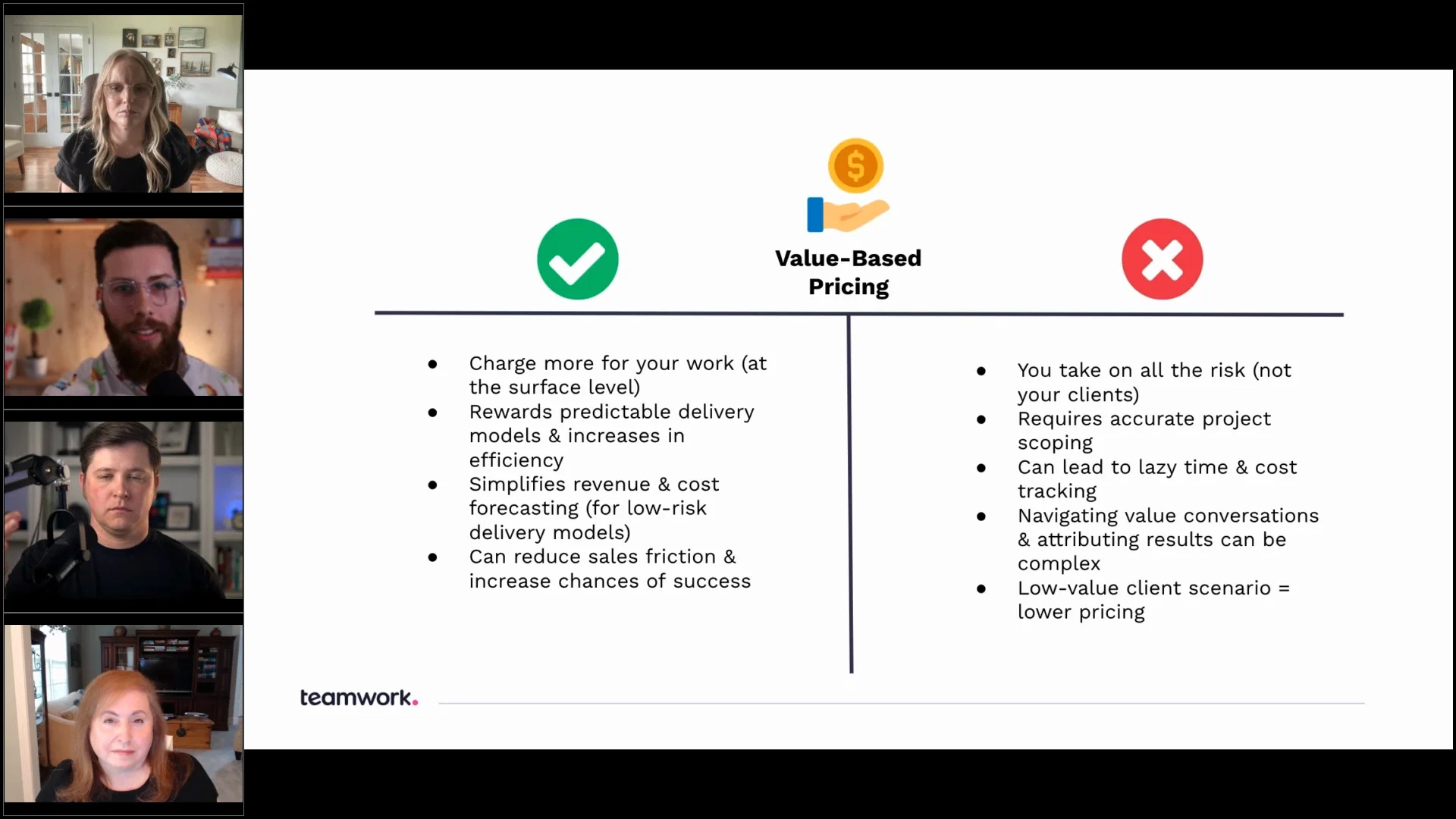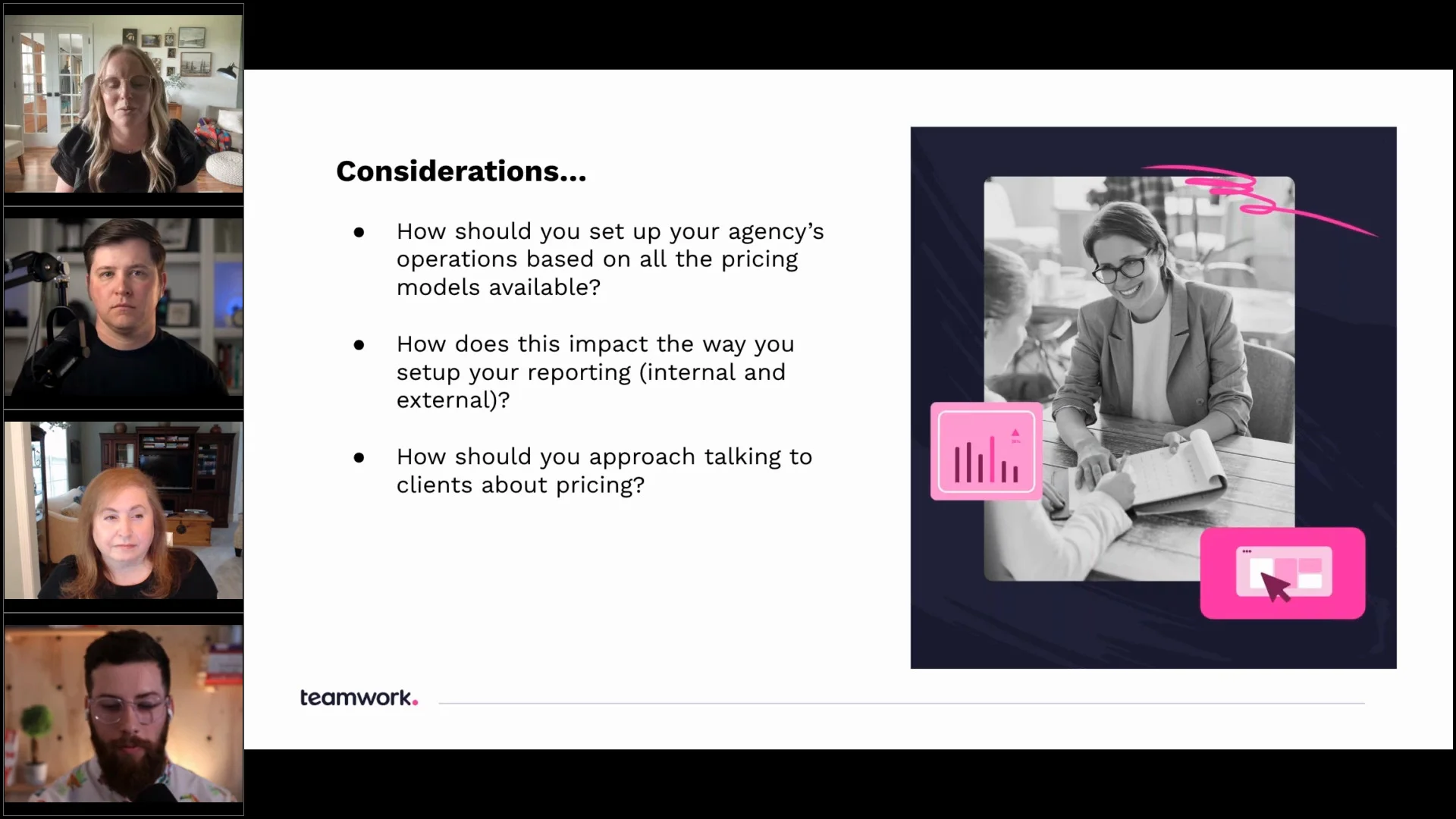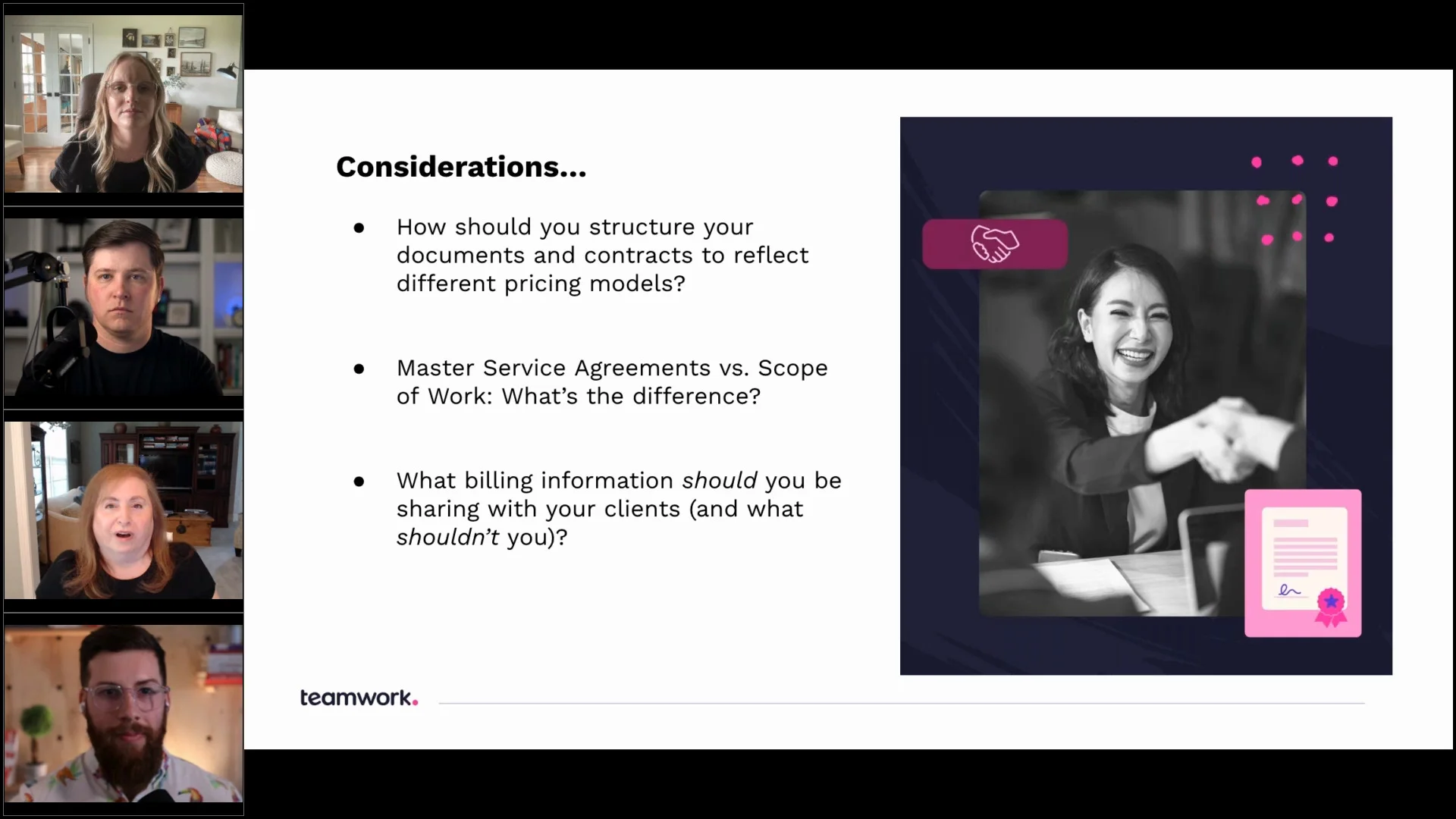Time and materials. Abstract time and materials. Flat fees. Value-based pricing.
With such a dizzying array of pricing models available today, it can be tricky to know which one is right for your agency.
If you’re feeling confused by it all, then read on. We recently brought together the brains of three pricing experts for our monthly webinar series – and we think you’ll be surprised (and even inspired) by what they had to say.
Host Logan Lyles (Head of Partnerships at Teamwork), was joined by Marcel Petitpas (Co-Founder and CEO at Parakeeto), Amber Kemmis (Chief Operating Officer at Instrumental Group), and Sharon Toerek (Founder at Legal+Creative), to discuss all of the below and more:
The pros and cons of value-based pricing models.
The alternative pricing model options available to agencies and how they work.
How to set up your agency operations based on these different models (and how to sell them to your clients).
How all of this impacts the way you structure your agreements and contracts to get the best results.
Before you check out the full episode, here are 3 key takeaways we learned from the discussion.
Value-based pricing isn’t necessarily the answer to all your problems

If you’re tuned into the latest pricing model trends on LinkedIn, you’ll be forgiven for thinking the industry has solved the pricing puzzle and that we can all put our feet up and watch the cash roll in.
The internet is awash with content crowning value-based pricing as the panacea for agency profitability. But is this really true, or too good to be true?
First, let’s get the definition of value-based pricing out the way so we’re all on the same page. This method involves pricing services based on the value they provide to customers, rather than on the cost of production, or the market price. For example, if you were building a website for a large e-commerce company doing $10 million in online sales per year, you could ascertain that a new site could boost their sales by 10% ($1 million per year) and charge $100,000 – justifying the price as being just 10% of the upside they stand the gain from the new website.
Sounds like a great model, right? According to Marcel, it’s worth considering it when “there is an outsized amount of value for solving a particular problem for a client. It allows you to really abstract pricing away from time, and start to attach it to something that inherently anchors the price to a much higher level.”
But this approach doesn’t come without its flaws. In the webinar, Marcel flags three issues that keep cropping up in conversations with his clients:
1. Value-based pricing doesn’t negate the need to track time!
“I’ve heard this lots of times before: we don’t track time because we do value-based pricing. But what you’re really saying here is that you don’t need to understand your cost basis. The issue with this is that now you don’t know if the project is really profitable, and how profitable it is.”
2. Navigating value conversations with clients can be really rough
“It requires a new way of thinking in terms of how we facilitate a conversation with the client, and it’s not always easy – especially because this is not a brand new pricing model, and clients have learned how to spot these.”
3. It only works when there is a high value opportunity with a client
“The upside of solving a conversation rate problem for a small e-commerce website is going to be far lower than solving it for a larger e-commerce site. If we’re going to be purists about this, we might end up getting paid a lot less for this deliverable than we need in order to be profitable.”
Key takeaway: A value-based pricing strategy can be a great option when you have a clear understanding of the client’s needs, preferences, and willingness to pay for the perceived value of your services (rather than your time to deliver it). But don’t be fooled into thinking it can be a lift-and-shift replacement for every project scenario. It doesn’t usually work for lower value problems, and it can be a tough option to sell into more pricing-savvy clients.
Use time and cost tracking data to inform client negotiations

“Underneath any pricing model, there should only be one objective – to set your agency up for profitability. We spend a lot of time talking about value in conversations with clients, but we’re not spending enough time talking about risk. How do we factor risk in so it’s setting us up for the right outcome?”
These words from Marcel will ring true for any agency leader who has struggled to scope a project accurately. Maybe the client is unsure what the deliverable(s) should be, or the project is so complex that it could take 100 hours, or 1 million hours, to execute.
Either way, it’s times like these that you need to leave some flexibility in your service delivery – otherwise you could end up overservicing massively and losing out on vital income.
But how do you do this? According to Amber, it’s all about using data to inform future client conversations – with two important elements being paramount for success:
1. Time tracking data at an individual level
“Recently, we’ve been using Teamwork to run custom reports on utilization and time tracking weekly. This enables us to check if the team is being compliant. For example, it tells you if someone logged 40 hours out of 40 hours that week, or whatever your expectation might be.”
2. Time tracking data at a project or retainer level
“On a project level, we set up notifications to go out when we hit 80%, and 100%, of agreed hours. For retainers, we still get those notifications, but we’re not looking at last month and thinking: “We went over by 5% – let’s all panic, cut back, and not drive as much value for the client.” Instead, we make adjustments after looking at a trend of two or three months. If we see three months in a row that we have added 20% to a client budget, that’s where that becomes a negotiation and a discussion with the client.”
The takeaway: Whichever pricing model you choose to adopt, you need to be tracking and evaluating time data regularly to see how your team is performing, and flag client work that is consistently going over budget. Only when armed with these insights can you have meaningful conversations with clients about flexing their agreements.
Create toolkits for every type of client engagement

So, you’ve looked at your service lines and how this impacts your pricing model. You’ve optimized your processes to stay on top of client negotiations.
But what about your client contracts – the thing that binds your relationships together in the first place? What do these agreements need to look like, and how can they be adapted for different pricing models?
For Sharon, agencies need to start thinking about client agreements in terms of them being toolkits – or “lego building blocks,” as she puts it.
In her words: “Do yourself a favor by thinking about the ways you generally work with clients, and then have a toolkit ready for each of those types of engagements. This takes so much time and pressure off that part of the conversation, especially when you’re in the new business phase of a client relationship, or renegotiating work.”
She also emphasizes the importance of nailing the Scope of Work (SoW) before anything else:
“I’m a strong advocate for developing a really well created SoW before you finalize your MSA. The reason for this is that some of the legal terms and liabilities will depend upon the scope of work that you’re going to be doing.”
The takeaway: You may have nailed your pricing strategy and processes, but your profitability hinges just as much on your client agreements. Take the time to build out a toolkit of SoW and MSA templates that reflect all of the ways you work with your clients – this will save you time and unwanted stress during the negotiation stage.
Want more valuable insights into agency pricing strategies and best practices? Watch the full episode now!
Choosing the right pricing model is tough, but with these insights you’ll be better placed to make the right decisions for your next client project.
Watch the full webinar on-demand here to learn more about all of the pricing models available to you, and how to set yourself up for success.
:quality(90))
:quality(90))
:quality(90))
:quality(90))
:quality(90))
:quality(90))
:quality(90))
:quality(90))
:quality(90))
:quality(90))